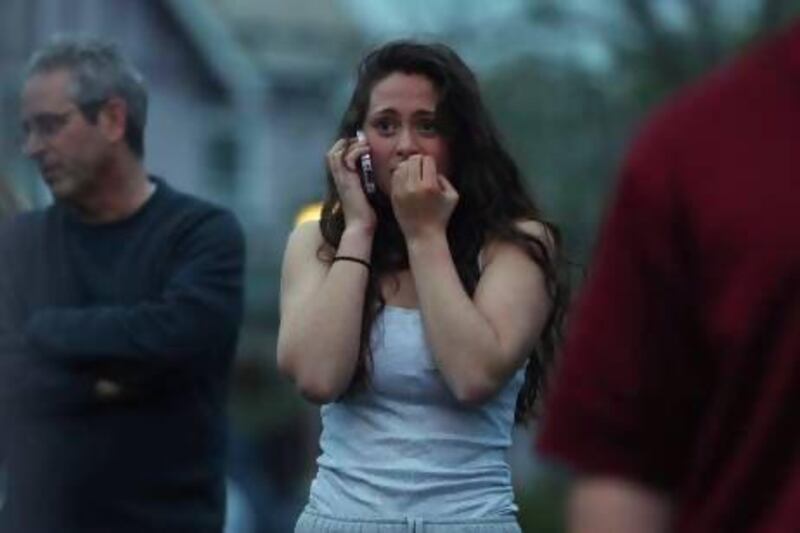The Abu Dhabi-based academic Iyad Rahwan watched the dramatic events in Boston a week ago with particular interest.
It was not just because the Masdar Institute associate professor used to live in Boston, including being a regular customer at the 7-Eleven convenience store robbed by the Tsarnaev brothers. Or even because he still had friends living in the gunfight zones.
Mostly it was because the Boston police's use of social media to enlist the help of the public in finding the marathon bombers bore uncanny parallels to the simulated manhunt for a team of criminals that Rahwan's team had successfully located by crowdsourcing.
The simulated manhunt was organised a year ago by the US State Department to test the growing capability of targeted social mobilisation, using the premise of a team of five jewel thieves who were on the run in New York, Washington DC, London, Stockholm and Bratislava.
On the very same day the police released images of the then-unidentified Tsarnaev brothers, an academic paper of the simulated manhunt was submitted to Cornell University postulating that the popularisation of smartphones, Facebook, Twitter and other social media vastly improved the ability to search.
"[The paper] has the main message that social media is capable of mobilising people and collecting information really fast, but this capability is limited," he said.
"You need people with a number of friends and you need them to be motivated [and] as fast as possible, given the distribution and response time.
"We used a model based on human social interaction to quantify how likely and how reliable this capability is. It only works when everything is absolutely perfect. If anything isn't perfect, it doesn't work."
Within 12 hours of starting the simulation, Rahwan's team's connections had located three of the five. What made the achievement even more remarkable was that it had been done from a base in Abu Dhabi, and none of the core members of his team lived in any of the five cities where the suspects were located.
He said their success in the face of geographical and linguistic hurdles came from learning the three main factors in a social media manhunt: you have to mobilise people, you have to aggregate the information and then you have to verify it.
Those are exactly the same challenges the Boston police faced. The first was not an issue: it would be difficult to imagine any group more motivated than Bostonians in the wake of the marathon bombing.
It was the other two factors in which the use of social media fell down, Rahwan said.
"In Boston, there wasn't a solution to the mass information and information overload. There are too many people posting too many conflicting pieces of information. You can't really tell what's relevant and what's accurate. "It's a cautionary tale for people who think that social media is changing everything and we can do this [find the bombers] by giving a voice to everyone. It amplifies the errors and if you can't filter the results, you get overloaded. That's what happened in Boston.
"It works where you have motivated people who are fewer in number and you get someone who is both interested in helping and capable.
"When you have everyone interested, you get incompetent or misinformed people or people who aren't taking the time and posting bad information. The damage can be quite substantial because it's amplified by social media."
There was no shortage of bad information as self-appointed cyber-sleuths used fragments of information to postulate theories about who was responsible. On sites such as Reddit and 4chan, anonymous posters were naming people they suspected of being the bombers.
The mainstream media picked up on the chatter. Before the photo of the Tsarnaevs was released, the New York Post featured a photo of two men on the front page under the heading "Bag men", implying they were responsible. The two men - Moroccan-born Salah Eddin Barhoun and his friend Yassine Zaime - were entirely innocent but were in fear of mob justice against them and their families. The identification of Arab-looking men echoed the allegations of racial profiling that had been raised when a Saudi bystander at the bombing had been tackled and detained when he had been running away like almost everyone else.
Once the Tsarnaevs' photograph was published, a missing Brown University student, Sunil Tripathi, was misidentified as the suspect we now know to be Dzhokhar Tsarnaev.
Rahwan said that in the end, social media produced far more noise than signal when it came to catching the marathon bombers. Success required a careful balance of enthusiasm, aggregation and verification with a "sweet spot" where each one was present in the right proportion. "In Boston, I suppose at some point the police started to ignore reports and they asked people to self-filter. People would send everything," he added. "The police specifically asked people to be extra careful because they didn't have the manpower.
"Let me say that social media is already pretty good at filtering information when it has time. If you want to learn about celebrity gossip or very long-term economic development - news that has a longer cycle and is repetitive - social media is good because we use real-life indicators like reputation because we have reliability. With these things we're getting pretty good.
"What we're not so good at is a one-off event like the Boston manhunt. You have no way of evaluating the experience or capability of someone who talks about a suspicious guy in the backyard.
"For one-off events and a short timescale, people apply two approaches to this problem. Some ideas discussed in academia are to use an algorithm to classify information to get rid of a big chunk of the noise. "The second approach is to use crowd filtering itself, so other people in the crowd filter the information. But how do you do this? And how do you deal with sabotage [through deliberate misinformation]?"
The crowd-filtering method could involve people only asking their reliable and accurate acquaintances to take part.
"In the Boston manhunt, that didn't work. We're working on a crowdsourcing platform for real-time verification. This is ongoing work and we hope to release a beta version in the summer.
"It's specifically to target people like this, when it's popular and the noise-to-signal ratio is too high. To use the crowd to filter others, you give people rewards for being good filterers."
Lessons can be learnt from Rahwan's team's success in the simulated manhunt. Five other well-organised teams were also vying for the US$5,000 (Dh18,365) but adopted a range of different strategies to motivate, aggregate and verify the crowdsourced information. One group was suspected of paying to suddenly gain 12,000 Twitter followers, presumably with the idea of appearing like the large and successful operation that would in turn attract real followers.
Rahwan's team used a kind of pyramid scheme where the person who found one of the suspects would receive $500 and the person who recruited them into the search would receive $100 and so on up the line. Recruiters were also paid $1 for every one they recruited into the challenge.
While other teams aggressively tweeted and had their messages ignored as spam, Rahwan's was selective and generated interest via tech blogs and online news. While datamining programmes rated another team as having a greater social media presence, the quality of Rahwan's team's messages won the day. Two other teams each found one of the five suspects but his found three.
The next time a developed country faces a situation similar to the one Boston underwent, he hopes the continued involvement of social media utilisation will enable it to play a greater role. However he said even if optimised, social media is just one tool in the authorities' array.
"People think social media is a silver bullet and we don't need a proper centralised media. I hope it's wishful thinking," Rahwan added.
"I think it still needs credibility and professional ability to evaluate content. Social media can sometimes be quite harmful.
"We need a science for social media. You can imagine one of these guys being falsely accused being killed by a mob. It's a dangerous deal."
John Henzell is a senior features writer for The National.






